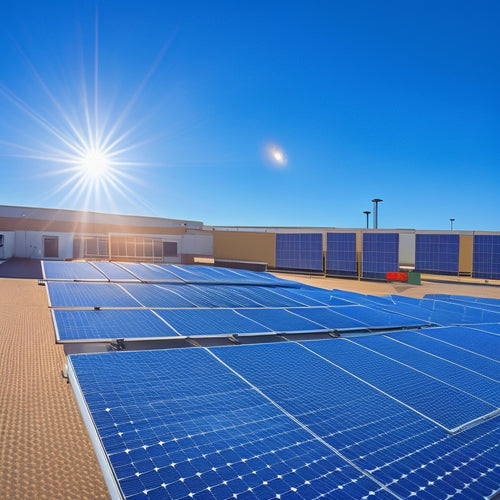
What Powers a Self-Sufficient Home?
Share
You rely on a combination of renewable energy sources, innovative technology, and sustainable practices to power your self-sufficient home. Solar power, wind energy, geothermal heating, hydropower, and biomass are all options that reduce reliance on fossil fuels and lower carbon footprints, leading to lower energy bills. To maximize energy output, you'll need to assess your energy needs, choose the right solar panels, and integrate energy storage and management systems. By doing so, you'll be able to utilize renewable energy, reduce energy waste, and achieve energy independence. Now, take the next step and investigate the details that'll bring your self-sufficient home to life.
Key Takeaways
- A self-sufficient home is powered by harnessing renewable energy sources like solar, wind, geothermal, hydropower, and biomass to reduce reliance on fossil fuels.
- Solar power systems promote energy independence, decrease energy bills, and enhance environmental quality with zero emissions and a significant reduction in carbon footprint.
- Energy storage and management are crucial, utilizing reliable battery technology and efficient inverters to store excess energy and enable energy independence.
- Maximizing energy output potential involves focusing on energy conservation, sustainable landscaping, and passive heating techniques to further reduce energy needs.
- Monitoring energy production and consumption, along with renewable incentives, help optimize system performance and reduce upgrade costs, leading to long-term savings.
Harnessing Renewable Energy Sources
In pursuit of energy independence, you'll want to investigate utilizing renewable energy sources to power your self-sufficient home.
Energy needs assessment is essential for determining system size solar power solutions, ensuring that your renewable energy system meets your energy requirements.
Two key options to evaluate are wind energy and geothermal heating. Wind energy captures the power of wind using turbines, converting it into electricity. This clean energy source is ideal for rural areas with consistent wind patterns.
Geothermal heating, on the other hand, utilizes the Earth's natural heat to provide warmth. By installing a geothermal system, you can reduce your reliance on fossil fuels and enjoy a consistent, eco-friendly heat source.
Both options offer a reliable and sustainable way to power your self-sufficient home, reducing your carbon footprint and energy bills.
Benefits of Solar Power Systems
When you install a solar power system, you're tapping into a renewable energy source that reduces your reliance on fossil fuels. By switching to solar, you'll also eliminate your carbon footprint, producing zero emission power that's better for the environment.
Moreover, you'll see a significant decrease in your energy bills, as you generate your own electricity and reduce your utility costs. This translates to energy independence and autonomy, allowing you to break free from grid reliance and nurture community pride and ownership through shared energy initiatives.
In addition, solar power systems contribute to sustainability by reducing greenhouse gas emissions and promoting clean energy.
Renewable Energy Source
Your roof becomes a personal power plant with a solar power system, generating clean energy and slashing your reliance on the grid. As you investigate renewable energy sources, you'll find that solar power is just one of several options. You may also consider wind energy, geothermal systems, hydropower benefits, and biomass options to power your self-sufficient home.
| Renewable Energy Source | Benefits | Challenges |
|---|---|---|
| Solar Power | Energy independence, clean energy, renewable incentives | Intermittent energy supply, high upfront costs |
| Wind Energy | Cost-effective, sustainable practices, eco-friendly technologies | Noise pollution, visual impact |
| Geothermal Systems | Reliable, consistent energy supply, grid integration | High installation costs, limited availability |
Zero Emission Power
Switch to a renewable energy source and you'll find that solar power systems offer a unique advantage: zero emission power.
By utilizing sunlight, you'll reduce your carbon footprint and contribute to a cleaner environment. Compared to wind energy, geothermal heating, and hydropower solutions, solar power systems are a reliable and accessible option for many homeowners.
Achieving energy independence through sustainable practices like solar power also qualifies you for renewable incentives.
Meanwhile, biomass options can complement your solar setup, enhancing energy efficiency and resilience.
As you shift to a self-sufficient home, solar power systems provide an essential step towards minimizing your carbon footprint and maximizing energy efficiency.
Lower Energy Bills
Most households can expect to save hundreds of dollars annually on their energy bills by installing solar power systems.
You'll enjoy lower energy bills because solar power generates electricity on-site, reducing your reliance on the grid. This leads to significant savings, especially during peak sun hours.
By utilizing renewable energy, you'll not only reduce your energy expenditure but also contribute to sustainable living.
Solar power systems promote energy efficiency, allowing you to power your home while minimizing your carbon footprint.
With a well-designed system, you can expect to save up to 50% or more on your energy bills, making solar power a smart investment for your wallet and the environment.
Types of Solar Panels Available
How do you choose the ideal solar panels for your self-sufficient home when faced with numerous options?
You'll need to evaluate the types of solar panels available, each with its own benefits and drawbacks. Effective design guarantees reliability and efficiency in energy systems, and energy storage capacity and inverter efficiency are critical for seamless power supply off-grid energy systems.
Monocrystalline panels offer high efficiency but are expensive, while polycrystalline panels are more affordable but less efficient. Thin film technology is another option, providing flexibility and lower costs, but with lower efficiency. Bifacial solar panels can utilize energy from both sides, increasing output. Building integrated photovoltaics seamlessly integrate into your home's design.
When selecting, assess solar panel efficiency, lifespan, and installation considerations. Compare costs and weigh the environmental impact of each option.
Charging With Solar Energy Storage
Several factors influence the efficiency of your self-sufficient home's energy system, and solar energy storage is a critical component.
You'll need a reliable battery technology to store excess energy generated by your solar panels during the day for use at night or during power outages. This allows you to attain energy independence, reducing your reliance on the grid.
When selecting a solar energy storage system, consider factors like capacity, depth of discharge, and round-trip efficiency. A well-designed system will guarantee you can store and employ solar energy efficiently, providing a stable and consistent power supply.
Inverters for Efficient Energy Flow
Since you've selected a suitable solar energy storage system, you can now focus on guaranteeing that the energy flows efficiently throughout your self-sufficient home.
Inverters play a vital role in this process, converting DC power from your solar panels or energy storage system to AC power for your home's appliances. This energy conversion is fundamental for achieving grid independence.
To guarantee efficient energy flow, consider the following inverter features:
-
High efficiency ratings: Look for inverters with high efficiency ratings (>95%) to minimize energy losses.
-
Power factor correction: This feature guarantees that the inverter's output voltage and current are synchronized, reducing energy waste.
-
Grid sync capability: This allows your inverter to synchronize with the grid, enabling you to sell excess energy back to the utility company.
- Monitoring and control capabilities: Inverters with built-in monitoring and control features help you track energy production and consumption, optimizing your self-sufficient home's performance.
Maximizing Energy Output Potential
Frequently, homeowners overlook an essential aspect of their self-sufficient home: maximizing energy output potential. To achieve this, you'll want to focus on energy conservation through efficient appliances, sustainable landscaping, and passive heating techniques.
Smart home integration can also help optimize your energy usage. Additionally, using eco-friendly materials and implementing water conservation measures will further reduce your energy needs.
Conducting regular energy audits will help identify areas for improvement, and taking advantage of renewable incentives can offset the costs of upgrades.
Monitoring Your Solar Energy Use
As you optimize your energy usage and strive for grid independence, tracking your solar energy production becomes an essential component of your self-sufficient home.
Monitoring your solar energy use allows you to identify areas of improvement, optimize energy consumption, and guarantee your system is operating at its best. To get the most out of your solar energy system, consider the following:
-
Track energy production: Monitor the amount of energy your solar panels produce to identify patterns and optimize energy usage.
-
Analyze energy consumption: Understand your energy usage patterns to identify opportunities to reduce energy waste and optimize energy storage.
-
Detect system anomalies: Identify potential issues with your solar energy system, such as underperforming panels or inverters, to guarantee prompt maintenance.
- Optimize energy storage: Monitor your energy storage levels to ensure you're maximizing your energy independence and minimizing grid reliance.
Frequently Asked Questions
Can I Install Solar Panels on My Old or Damaged Roof?
You'll need a roof assessment to determine if your old or damaged roof can support solar panels; consider installation options like roof repairs or replacement before installing, or investigate alternative mounting methods like ground-mounted systems.
How Long Does It Take to Install a Solar Power System?
You'll typically spend 3-5 days on solar panel installation, depending on your system's size and complexity, but the entire installation timeline can take 2-6 months, considering permits, inspections, and utility approvals.
Are There Any Government Incentives for Solar Power Users?
As it happens, you're in luck! You can claim tax credits for installing solar panels, and, coincidentally, the government offers incentives for renewable energy users like you, providing a 26% tax credit on your solar power system's total cost.
Can I Use Solar Power to Charge My Electric Vehicle?
You can use solar power to charge your electric vehicle, maximizing electric vehicle benefits; a dedicated solar charging system can be installed, enabling you to utilize renewable energy and reduce your carbon footprint efficiently.
Do Solar Panels Require Regular Maintenance or Cleaning?
"An ounce of prevention is worth a pound of cure" holds true for solar panels, which you'll need to clean every 6-12 months to guarantee peak performance and extend their 25-30 year lifespan, depending on environmental factors and cleaning frequency.
Related Posts
-

Top 10 Off Grid Camping Gear Must-Haves
When you're off-grid camping, the right gear is crucial for a smooth expedition. Start with a durable, weather-resist...
-

Essential Solar Panel Mounts for Commercial Properties
When it comes to essential solar panel mounts for your commercial property, durability and wind resistance are key fa...
-

Top Solar Powered Camping Fans for Camping Enthusiasts
If you're a camping enthusiast, a solar-powered fan can be a transformative element for your outdoor experience. Thes...


